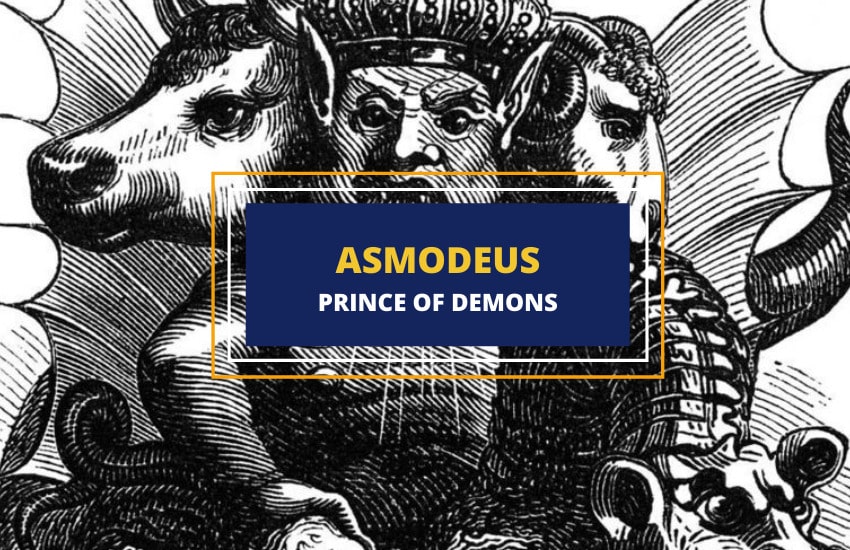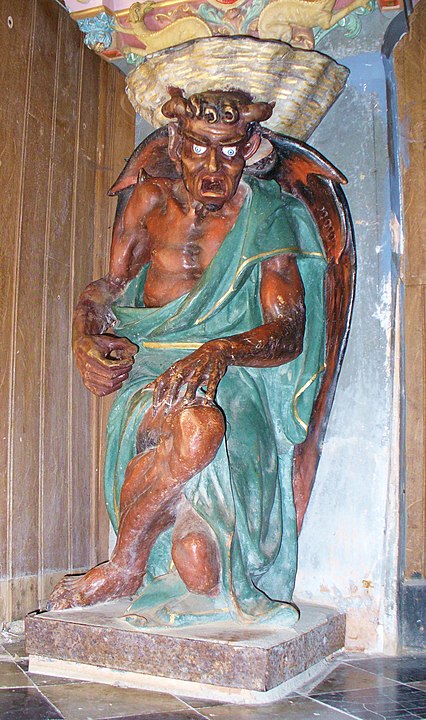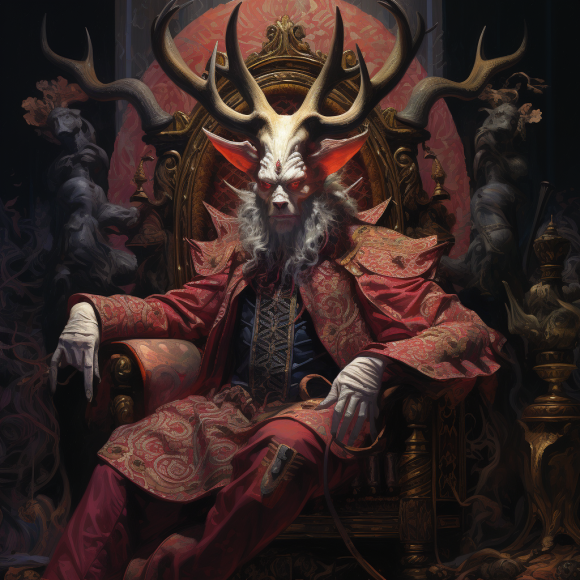
Table of Contents
Asmodeus is a demon of the first order, referred to by some as the “king of demons,” “prince of demons,” and “king of the earthly spirits”. He is one of the seven princes of hell, each assigned responsibility for one of the seven deadly sins. As such, Asmodeus is the demon of lust.
His primary objective is to disrupt the sexual relationship of married couples, whether by interfering in the consummation of a marriage on the wedding night or by enticing husbands and wives to pursue extramarital sexual exploits.
Origin and Etymology of Asmodeus
The name Asmodeus has numerous alternative spellings including Asmodia, Ashmedai, Asmodevs, and several other similar iterations. Most scholars agree that Asmodeus has his origins in Zoroastrianism, the ancient religion of Persia.

In the Avestan language “aeshma” means wrath, and “daeva” means demon. Though the compound name Aeshma-daeva is not found in the sacred text, there is a demon of wrath, “daeva Aeshma”. This etymological origin connects with the well-attested to influence of Persian culture upon post-exilic Judaism.
What Does Asmodeus Look Like?
The well-known Dictionnaire Infernal (1818) by Jacques Collin de Plancy is the source for what is today the accepted physical characteristics of Asmodeus.
Traditionally, Asmodeus has three heads, one like a sheep, one like a bull, and one like a man, yet with a hooked nose, pointy ears and teeth, and fire coming from his mouth. His torso is also that of a man, but below the waist, he has the feathered legs and feet of a rooster.
Along with his unusual appearance, Asmodeus is known to ride a lion with the wings and neck of a dragon. This became the accepted view after the Archbishop of Paris approved the drawing.
Asmodeus In Jewish Texts
Asmodeus does not appear in any of the canonical books of the Hebrew Bible but figures prominently in several extra-canonical texts such as the Book of Tobit and the Testament of Solomon. 2 Kings 17:30 does contain a reference to the god Ashima who was worshipped by the “men of Hamath” in Syria. While the spelling is similar to Aeshma in the Avestan language, it is difficult to make a direct connection.
1. Book of Tobit
Asmodeus is the primary antagonist in the Book of Tobit, a deutero-canonical text written near the turn of the 2nd century BCE. The Book of Tobit occupies a vague space in Jewish and Christian scripture. It is not a part of the Hebrew Bible but is recognized as canonical by the Roman Catholic and Orthodox Church. Protestants place it in the Apocrypha, a collection of writings with ambiguous status depending on the denomination.
The Book of Tobit is a fictional story centering around two Jewish families. The first being the family of Tobit. His son Tobias is sent on a journey from Ninevah to the city of Ecbatana in Media, modern-day Iran. Along the way, he is aided by the angel Raphael.
In Ecbatana, he meets Sarah, the daughter of Raguel, who is being tormented by the demon Asmodeus. Asmodeus has fallen in love with Sarah to such an extent that he has thwarted her marriage to seven different suitors by killing each groom on their wedding night before they can consummate the marriage. Tobias is the next suitor to pursue Sarah. He is successful, being able to restrict the efforts of Asmodeus with aid from Raphael.

2. Talmud and Testament of Solomon
In both the Talmud and the Testament of Solomon, Asmodeus plays a role in the building of Solomon’s temple.
The Talmud is the primary text of rabbinic Judaism. It is the central source for Jewish religious law and theology. Here Ashmedai makes several appearances. In one legend, he has been tricked by Solomon to aid in the construction of the temple. In other related stories, he falls for Solomon’s wife.
In an extended legend, he has been bound in chains to build Solomon’s temple but tricks Solomon into setting him free. Upon release, he tosses Solomon a significant distance into the desert and disguises himself to take Solomon’s place as king. Several years later, Solomon returns and defeats Ashmedai using a magic ring.
Asmodeus has a similar role in the Testament of Solomon, a pseud-epigraphical text written and compiled over several centuries from approximately the third century CE throughs the Middle Ages. In this narrative, Solomon invokes the aid of Asmodeus in the building of the temple. During the course of their work, Asmodeus predicts that Solomon’s kingdom will be divided among his sons. Further questioning reveals facts about Asmodeus, such as his being thwarted by Raphael.
Demonology References
Asmodeus appears later in several well-known compendiums of witchcraft and demonology. The Malleus Maleficarum describes him as the demon of lust. Written in 1486 by a German clergyman Heinrich Kramer, the Hammer of Witches outlines sorcery as a crime of heresy and the various means of torture to be used in obtaining confessions to such crimes.
In 1612 French inquisitor Sebastian Michaelis agreed with this description, including Asmodeus in his classification of demons. According to other sources of the High Medieval period, Asmodeus’ power was greatest during the month of November or during the zodiac sign of Aquarius. He is considered one of the kings of hell just below Lucifer and sometimes connected with Abaddon.

Christian Thought
In Christian thought, Asmodeus has held a similar position of primacy and temptation. According to some accounts, Gregory the Great, the pope in Rome from 590 until 604 CE, included Asmodeus in the Order of Thrones, one of the top rankings of angels.
This points to the high-status Asmodeus occupied before the fall of the angels with Satan and corresponds with his high title among the demons since demons are just fallen angels.
In later years other vices were added to the repertoire of this lascivious demon, most notably gambling. His appearance and demeanor also underwent somewhat of a makeover. He becomes far more attractive, at least at first glance. His human face is pleasant to look at, and he is well dressed, hiding his feathered leg and dragon’s tail.
The use of a walking stick distracts from the limp he walks with caused by his clawed foot. He also becomes much less antagonistic and bent upon the evils of murder and destruction. Instead, he transforms into something of a good-natured, mischievous instigator.
Other Notable Appearances
The legend of Solomon and Asmodeus does appear in Islamic culture. As with many other points of Jewish history, there is carry-over into Islamic history and belief. In the Islamic version of the story, Asmodeus is known as Sakhr, which translates to Rock. This is a reference to his fate after being defeated by Solomon. The demon is clapped in iron, imprisoned in a box of rocks which is then cast into the sea.
By modern times Asmodeus largely disappears from cultural references, perhaps due to the softening he underwent during the preceding centuries. He appears as a recurring character in season thirteen of the television series Supernatural. He features prominently in the role-playing game Dungeons and Dragons, having the same role as the King of the Nine Hells in each iteration of the game.
In Brief
Asmodeus is a demon whose influence and appearance have faded over time. While most people would have known and feared the demon of lust with his horrific appearance during much of Western Civilization, today, few would recognize his name.








